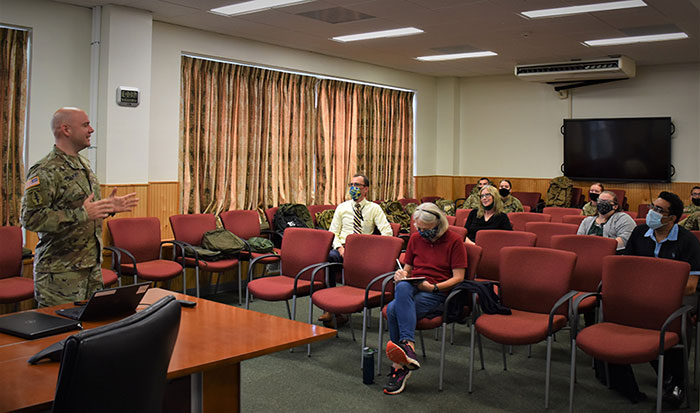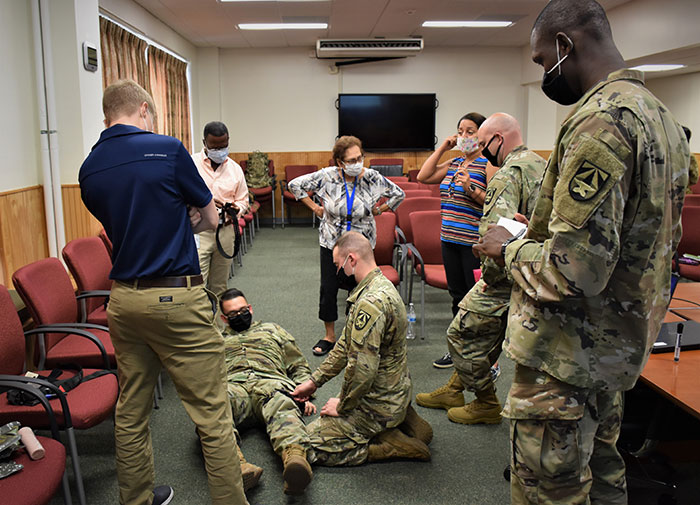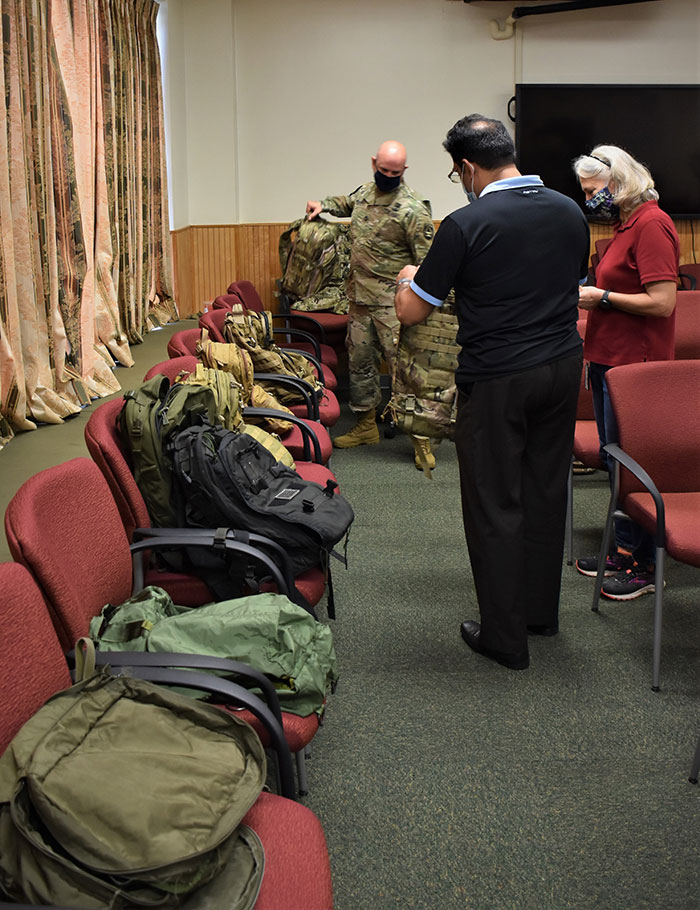USAMMDA Provides Information Session on Warfighter "Point-of-Injury" Awareness

On the battlefield,it takes quick-thinking, knowledgeable combat medics to ensure the health and safety of injured Service Members. Recently, the U.S. Army Medical Materiel Development Activity at Fort Detrick, Maryland, hosted a pair of information sessions to provide a glimpse into the typical life of a "68 Whiskey," or Army combat medic specialist, in theater.
"The topic of these sessions was a 'point-of-injury' overview for the staff within the U.S. Army Medical Research and Development Command — and especially for our team here at USAMMDA — to provide an understanding of what the Warfighter, and more specifically the 68 Whiskey, goes through at the point-of-injury," said Army Sgt. 1st Class Daniel McGarrah, combat medic and senior enlisted advisor to the commander at USAMMDA.
Having served with the U.S. Army's Special Operations Command, McGarrah is very familiar with the role and responsibilities of the combat medic. Not only did he lead the instruction of this course, he designed the content and curriculum as well.
"Each session included the Tactical Combat Casualty Care protocols, as well as a hands-on demonstration of the medical equipment that we use, and the various components that are included inside of the combat medic bag and the Army's Individual First Aid Kit — and why weight and space issues are important," he explained.
Through a combination of visual material, video clips and in-class presentations, the two-hour course provided a great deal of information for the participants, who appeared very engaged throughout both sessions.
McGarrah began the class by offering a mantra to keep in mind when treating a trauma patient: "B-B-W — Stop the Bleeding, Keep them Breathing, and Keep them Warm." He said that while most medics will immediately treat uncontrolled hemorrhage and respiratory distress, some may not realize how quickly hypothermia can set in, so the injured person should be wrapped to ensure as much body warmth as possible during transport to a medical treatment facility.
"Hypothermia will affect patient survival in any season or temperature," said McGarrah. "Current data shows the chance of survival for a trauma patient with a four-degree Fahrenheit drop in body temperature is only 25 percent; but if it falls to 90 degrees or below, the patient's chances are zero. So always keep them warm."

The course material included scenarios involving massive hemorrhage, circulation issues, and the proper placement of tourniquets to prevent blood loss. Equal attention was given to airway and breathing complications, head injuries, and the methods used to alleviate tension pneumothorax, or compression within the chest. This was followed by a discussion of medical evacuation of the patient, and the importance of following a predesigned evacuation plan that takes into account a variety of problems that may occur on the way to the MTF.
While the first half of the course was presented traditionally by McGarrah from the front of the room, he employed the assistance of fellow combat medics for hands-on demonstrations offered during the second half. The class was divided into two smaller groups that spent time reviewing an Army combat medic bag and first aid kit, and working with a medical mannequin to discuss the items and methods used to treat airway blockage and respiratory distress.
Army Sgt. Nyketa Summerour, a combat medic who works within the Teaching and Education Department at the U.S. Army Medical Research Institute of Infectious Diseases, felt fortunate to be among those called upon by McGarrah to help with the individual breakout sessions.
"I believe this session was very important, because it helped to show civilians what we do as combat medics, as well as the equipment we use and how we use them," she said. "Even with something as 'simple' as a tourniquet, we were able to show the class how this is used, and the importance of using it properly to stop blood loss. As Sgt. 1st Class McGarrah said, uncontrollable hemorrhage is the leading cause of death on the battlefield."
USAMMDA was asked to host this information session via a joint request from the Army's Capability Development Integration Directorate and the U.S. Army Medical Research and Development Command, which is USAMMDA's higher headquarters. Earlier this year, CDID offered to provide this training at Fort Sam Houston, Texas, for USAMRDC staff members. However, the COVID-19 pandemic placed limitations on military and government travel.
"As a compromise to this, leadership decided that I could teach some of the same courses for our personnel here at Fort Detrick, once the COVID-19 crisis lessened," said McGarrah. "I am able to provide the basics of the course, so that our staff members have a solid understanding of the fundamentals before they travel to Fort Sam Houston for the longer, in-depth course, once they are able."

Marianne Erlichman, product management support for USAMMDA's Force Health Protection Division, attended the information session and was very impressed with the team's presentation of the material.
"Sgt. 1st Class McGarrah and his team presented the information in a way that could be easily understood by people who are not familiar with a battlefield scenario," she said. "They all encouraged questions from the audience, and the slides and videos were excellent."
"I think this is a very worthwhile course that could benefit everyone who attends," she added. "The combat medics in the class were able to show us their equipment, including tourniquets to stop bleeding quickly, syringes that contain small compressed gauze bandages to inject into a wound, breathing tubes to insert for someone who is having difficulty breathing, and material to seal up a chest wound. I really found everything to be very interesting and helpful."
For the past 35 years, USAMMDA has been tasked with managing the development of essential medical products and devices requested by the Department of Defense for our military forces, and McGarrah believes this type of information session can provide valuable insight regarding the critical items developed and maintained by USAMMDA.
"This course was created specifically for our civilians, and some military personnel who may not have extensive combat experience," said McGarrah."Hopefully, they will get a better idea of why we do what we do, and why it's important to understand what our products do."
"We need to learn from the product failures that have happened in the past, in order to prevent this from ever happening again," he added."Our Warfighters are counting on us to do this."
McGarrah said that he intends to offer these information sessions once a month going forward, so that more personnel may have the opportunity to attend. Based upon the success of this particular topic, he hopes to provide additional information sessions related to the work and mission of USAMRDC and USAMMDA.
About USAMMDA
USAMMDA is a subordinate command of the U.S. Army Medical Research and Development Command, under the Army Futures Command. As the premier developer of world-class military medical capabilities, USAMMDA is responsible for developing and delivering critical products designed to protect and preserve the lives of Warfighters across the globe.These products include drugs, vaccines, biologics, devices and medical support equipment intended to maximize survival of casualties on the battlefield.












